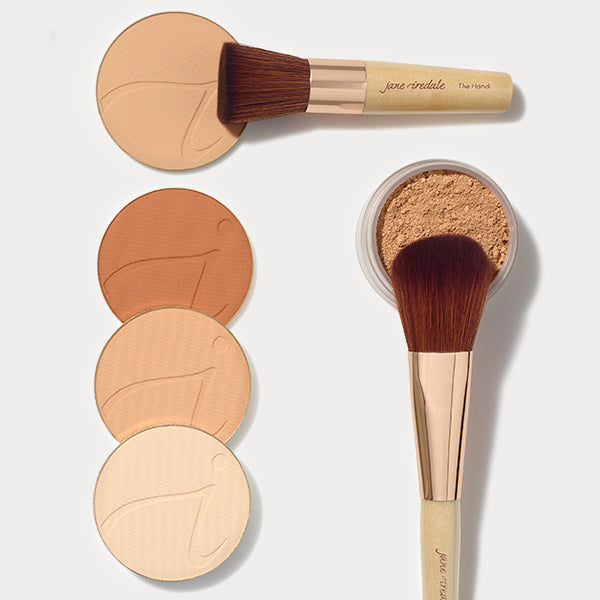One of the biggest questions I hear is “Do I really need a powder in my makeup routine?” Before answering that, we first must examine an even larger question, “What is the difference between a setting powder and a finishing powder?”
Setting Powder vs Finishing Powder
Setting powder (the history of which can be traced back to ancient Egypt!) prevents complexion products from rubbing off, they reduce shine and increase longevity. Finishing powder (often translucent or sheer) offers a filter-like finish, blurring imperfections in the skin. Both can come in either pressed or loose formulas.
Setting powder prevents complexion products from rubbing off, they reduce shine, and increase longevity. Finishing powder (often translucent or sheer) offers a filter-like finish, blurring imperfections in the skin. Both can come in either pressed or loose formulas.

Key ingredients such as Boron Nitride make it so that jane iredale’s PurePressed Base and Amazing Base offer the best of both worlds. Both formulas come in easy-to-match skin tone shades, can lock any of our skin-loving foundations in place, and with their skin-like finish, both options offer that filter-like effect of a finishing powder.

PureMatte and Amazing Matte are more like classic finishing powders, as both formulas are translucent and contain organic pulverized rice starch to control oil. PureMatte is a semi-matte finish suitable for oilier skin types, while Amazing Matte offers a more luminous finish, best suited for drier skins. PureMatte and Amazing Matte provide a filter-like finish that never appears cakey or dry.
Setting Powder Concerns
Make sure that your setting powder or finishing powder work with your skincare routine as well. Powder use can also bring up a laundry list of skin concerns such as:
- Will powders break me out?
- Will powders make my skin dry?
- Will powders enhance my fine lines and wrinkles?
Will setting powder make me break out?
Setting powder should not make you break out, but make sure to be on the lookout for ingredients like parabens, which are preservatives that are used to keep makeup germ-free that can affect your hormones, and any synthetic dyes or colorants that can cause skin irritations and acne breakouts. Mineral oils in setting powders also coat the skin and clog pores which can increase the likelihood of break outs. jane iredale formulas do not contain any of these ingredients.
Will setting powder make my skin dry?
Setting powder for oily skin can make your oily skin appear more matte but setting powder itself should not dry out your skin. Keep an eye out for ingredients that could dry out your skin, including talc, which absorbs moisture, enhances the texture of the skin, causes flashback in photos, and has even been linked to certain cancers. All setting powders from jane iredale are talc-free.
You can also use jane iredale’s gentle setting powders for dry skin, as our formulas do not contain these ingredients that will dry out your skin further.
Will setting powder enhance my fine lines and wrinkles?
Setting powder and finishing powder help to smooth the appearance of the skin, so they should not enhance any fine lines. Be sure to avoid ingredients that could damage your skin though, such as synthetic fragrances that are highly irritating to the skin and can be endocrine disruptors. Also avoid chemical sunscreens in your setting powder, as they work by absorbing light, which causes more damage to the skin rather than protecting it. Avoid phthalates too, which are plasticizers used for spreadability but are reproductive and developmental toxins. You won’t find any of these ingredients in jane iredale formulas.
Applying Setting Powder
Choosing the proper tools is equally as important to choosing the right setting powder formula; here are our current recommendations:
